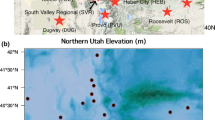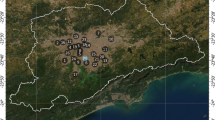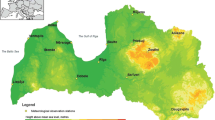Abstract
The genesis and dynamics of fog take place under certain meteorological conditions. Thus quantification of the differences in different meteorological variables between foggy and non-foggy days can provide insight into the dynamics of fog; such contrasts can also help to identify and quantify precision and the accuracy required in the meteorological forecasts for driving fog prediction models. However, systematic evidence and quantification of differences in meteorological variables for foggy and non-foggy days are missing. Based on analyses of composites of differences between meteorological variables (temperature, relative humidity, wind and dew-depression) for days with no fog, mild fog and dense fog (based on visibility) days over Delhi, a fog-prone metropolis, we show that consistent and appreciable distinctions exist between days with fog and no fog (characterized in terms of hourly visibility) for both December and January. An important finding is that the differences persist not only near the surface, but also at 850 hPa level. Expectedly but consistently, the contrasts were stronger for long-duration (duration ≥4 h) than those for short duration (duration <2 h) fog; the contrasts were also stronger for dense (visibility <500 m) fog. The average differences between non-foggy and dense fog (duration ≥4 h) in composite temperature, relative humidity and wind are of the order of 3 °C, 10 % and 5 m/s, respectively; these findings can help to assess and validate meteorological forecasts for driving fog prediction. Fog is a high-impact event over many locations world-wide; while the present analysis is for a specific location, the methodology is generic to be applied over any fog-prone location.











Similar content being viewed by others
References
Ahrens DC (1988) Meteorology today. West Publishing Company, New York, p 171
Ali K, Momin GA, Tiwari S, Safai PD, Chate DM, Rao PSP (2004) Fog and precipitation chemistry at Delhi, North India. Atmos Environ 38:4215–4222
Bhowmik SKR, Sud AM, Singh C (2004) Forecasting fog over Delhi—an objective method. Mausam 55(2):313–322
Bott A, Trautmann T (2002) PAFOG—a new efficient forecast model of radiation fog and low-level stratiform clouds. Atmos Res 64(1–4):191–203
Brown R, Roach WT (1976) The physics of radiation fog: II–a numerical study. Q J R Meteorol Soc 102:335–354
Choudhury S, Rajpala H, Sarafa AK, Panda S (2007) Mapping and forecasting of North Indian winter fog: an application of spatial technologies. Int J Remote Sens 28:3649–3663
Choularton TW et al (1981) A field study of radiation fog in Meppen. West Germany. Quart J Roy Meteor Soc 107:381–394
Clark PA, Hopwood WP (2001) One-dimensional Site-specific forecasting of radiation fog. Part I: model formulation and idealized sensitivity studies. Meteorol Appl 8:279–286
Dynkerke PG (1991) Radiation fog: a comparison of model simulation with detailed observation. Mon Weather Rev 11:324–341
Fuzzi S et al (1992) The Po valley fog experiment 1989: anoverview. Tellus Set B J4:448–468
Goswami P, Rakesh V, Patra GK, Prakash VS (2012) Real-time quantitative rainfall forecasts at hobli-level over Karnataka: evaluation for the winter monsoon 2010. Curr Sci 102(10):1426–1433. (http://www.currentscience.ac.in/Volumes/102/10/1426.pdf)
Gultepe I et al (2007) Fog research: a review of past achievements and future perspectives. Pure appl Geophys 164:1121–1159
Houssos EE et al (2012) On the atmospheric circulation characteristics associated with fog in Ioannina, north-western Greece. Int J Climatol 32(12):1847–1862
Huffman GJ, Adler RF, Bolvin DT, Gu G, Nelkin EJ, Bowman KP, Hong Y, Stocker EF, Wolff DB (2007) The TRMM multisatellite precipitation analysis (TMPA): quasi-global, multiyear, combined-sensor precipitation estimates at fine scales. J Hydrometeorol 8:38–55
Jenamani RK (2007) Alarming rise in fog and pollution causing a fall in maximum temperature over Delhi. Curr Sci 93(3):314–322. (http://www.currentscience.ac.in/Downloads/article_id_093_03_0314_0322_0.pdf)
Meyer MB, Jiusto JE (1986) FOG-82: a cooperative field study of radiation fog. Bull Am Meteor Soc 67:825–832
Meyer MB, Lala GG (1990) Climatological aspects of radiation fog occurrence at Albany, New York. J Clim 3(5):577–586
Mitra AK, SankarNath, Sharma AK (2008) Fog forecasting using rule-based fuzzy inference system. J Indian Soc Remote Sens 36(3):243–253
Nakanishi M (2000) Large-eddy simulation of radiation fog. Bound Layer Meteor 94:461–493
Pagowski M, Gultepe I, King P (2004) Analysis and modeling of an extremely dense fog event in Southern Ontario. J Appl Meteor 43:3–16
Pasricha PK, Gera BS, Shastri S, Maini HK, Ghosh AB, Tiwari MK, Garg SC (2003) Role of the water vapor greenhouse effect in the forecasting of fog occurrence. Bound Layer Meteorol 107(2):469–482
Rakesh V, Goswami P (2014) Evaluation of high resolution rainfall forecasts over Karnataka for the 2011 southwest and northeast monsoon seasons. Meteorol Appl. doi:10.1002/met.1438
Roach WT, Brown R, Caughey SJ, Garland JA, Readings CJ (1976) The physics of radiation fog: I- a field study. Q J R Meteorol Soc 102:313–333. doi:10.1002/qj.49710243204
Rodhe B (1962) The effect of turbulence on fog formation. Tellus 14(1):49–86
Saraf AK, Bora AK, Das JD, Rawat V, Sharma K and Jain SK (2010) Winter fog over the Indo-Gangetic Plains: mapping and modelling using remote sensing and GIS. Nat Hazards 58(1):199–220. doi:10.1007/s11069-010-9660-0
Welch RM, Ravichandran MG, Cox SK (1986) Prediction of quasi-periodic oscillations in radiation fogs. Part I: comparison of simple similarity approaches. J Atmos Sci 43:633–651
Zhou B, Ferrier BS (2008) Asymptotic analysis of equilibrium in radiation fog. J Appl Meteorol Climatol 47(6):1704–1722. doi:10.1175/2007JAMC1685.1
Acknowledgments
This work was supported by a research grant under a network project, Integrated Analysis for Impact, Mitigation and Sustainability (IAIMS), CSIR, Government of India. The high-performance computing (HPC) facility of CSIR Centre for Mathematical modeling and Computer Simulation Institute (CSIR C-MMACs) is acknowledged gratefully for providing fast access to archived data.
Author information
Authors and Affiliations
Corresponding author
Additional information
Responsible Editor: R. Roebeling.
Electronic supplementary material
Below is the link to the electronic supplementary material.
703_2015_384_MOESM1_ESM.tif
Supplementary material 1 (TIFF 637 kb) Supplementary Fig. S1 Wintertime (December-January) climatology (1980-2012) of (a) surface temperature, (b) surface relative humidity and (c) sea level pressure and 1000 mb wind vectors from NCEP (2.5° × 2.5°) reanalysis data
Rights and permissions
About this article
Cite this article
Goswami, P., Sarkar, S. Analysis and quantification of contrasts in observed meteorological fields for foggy and non-foggy days. Meteorol Atmos Phys 127, 605–623 (2015). https://doi.org/10.1007/s00703-015-0384-2
Received:
Accepted:
Published:
Issue Date:
DOI: https://doi.org/10.1007/s00703-015-0384-2




